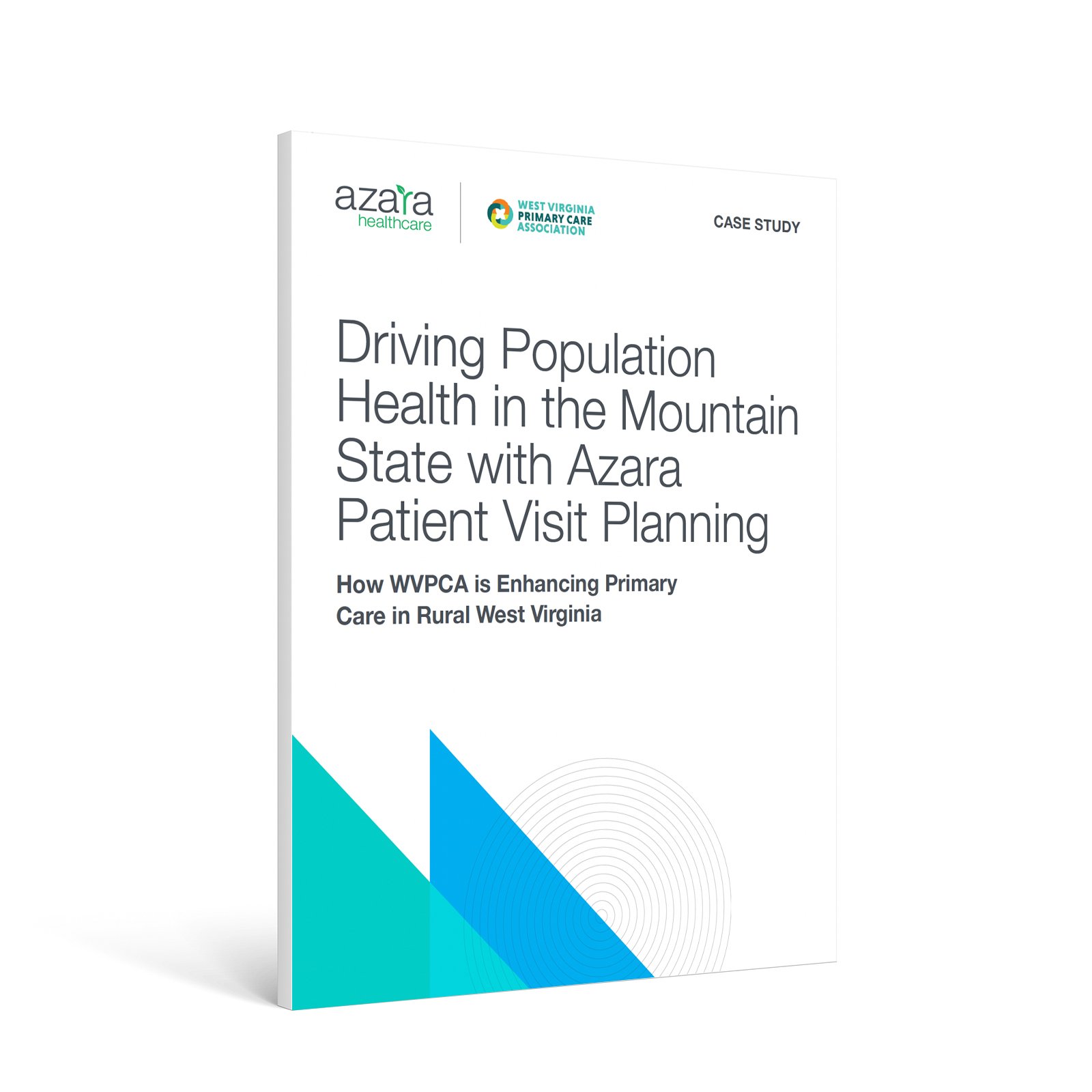Driving Population Health in the Mountain State with Azara Patient Visit Planning
How WVPCA is Enhancing Primary Care in Rural West Virginia

Overview
Since 1983, the West Virginia Primary Care Association
(WVPCA) has served as a driving force for health equity
and access, representing more than 550 Community
Health Center sites across the state. As the federally
designated primary care association, WVPCA bridges
the gap between local health centers and state and
federal partners, supporting a system of care that
reaches nearly one-third of West Virginia’s population.
Through strategic advocacy, workforce support,
quality improvement, and data-informed innovation,
WVPCA empowers its members to deliver high-quality,
affordable care in some of the nation’s most rural and
medically underserved regions.
In 2022, WVPCA funded a network-wide, two-phase
initiative to strengthen data quality and prepare its
members for value-based care. Phase one of the project
focused on data validation efforts to ensure measures
accurately reflected real-world documentation and
workflows, and the second on standardization of pre-visit planning so teams could utilize consistent, real-time
insights and optimize team-based care models.
Southern West Virginia Health System, CHANGE, Inc., and St. George Medical Clinic were among the network’s early participants. Their experiences, highlighted here, demonstrate how the statewide effort is helping a cohort of Federally Qualified Health Centers (FQHCs) build a trusted data foundation, reduce duplication, and turn every visit into an opportunity to close gaps and raise care quality across the network.
The Challenge
Universally, WVPCA’s members faced the same underlying barriers: stretched care teams, inconsistent pre-visit workflows, and fragmented data that made it hard to run effective daily huddles or act on quality opportunities in real time. The result was avoidable duplication, missed follow-ups, and uneven performance on priority measures.
Common operational hurdles included:
- Inconsistent huddles and visit prep, leading to duplicative effort and missed care gaps
- Fragmented EHR data and mapping issues, limiting reliable, apples-to-apples reporting
- Non-standardized workflows and communication, especially across locations and provider teams
- Staff capacity constraints, making manual chart prep and list-pulling unsustainable
- Variable performance on key quality measures (e.g., depression screening follow-up, BMI plans, A1c testing)
Despite various starting points, Southern West Virginia Health System, CHANGE, Inc., and St. George Medical Clinic, underscored a shared reality across WVPCA’s network: fragmented workflows, inconsistent huddles, and uneven data fidelity were slowing progress on critical care quality goals. Leaders saw a clear opportunity to streamline pre-visit planning, improve team communication, and align daily clinic work with population health priorities, setting the stage for a coordinated, network-wide solution.
The Solution
To strengthen data integrity and embed population health into daily care delivery, WVPCA partnered with Azara Healthcare to launch a two-part initiative that combined rigorous data validation with a standardized approach to pre-visit planning.
Phase 1: Four-week DRVS data validation ensuring that each center’s DRVS platform measures accurately reflected real-world documentation and workflows.
Phase 2: Standardize pre-visit planning via Azara Healthcare’s Patient Visit Planning (PVP) solution, giving care teams consistent, real-time insights during every encounter.
Guided by Azara, centers including Southern West Virginia Health System, CHANGE, Inc., and St. George Medical Clinic, worked through a structured implementation process that included validating data, configuring alerts and standing orders, training staff across roles, and developing standardized huddle procedures.
Chosen for its ability to deliver real-time, patient-specific insights directly into care team workflows, the PVP allows staff to plan, prepare and optimize visits before a patient arrives. By surfacing actionable alerts tied to preventive care, chronic condition management, and social risk factors, the PVP enables teams to conduct focused morning huddles and execute standardized care protocols with greater efficiency and consistency.
"The PVP helped us shift from reactice to proactive. Instead of discovering care gaps during the visit, we're prepping for them in advance, ensuring everyone walks in with a clear plan”
Solena Roberts, PA-C, Chief Medical Officer at St. George Medical Clinic
Organized by provider schedule and appointment time, the PVP gives teams a concise snapshot of each day’s visits, flagging what care is needed, which gaps are due or overdue, and what patient-specific risks or conditions should guide the conversation.
For every patient on the schedule, the Patient Visit Planning report displays:
- Demographics (i.e. age, gender, preferred language, MRN)
- Clinical context (i.e., diagnoses, chronic conditions, PHQ-9 scores, risk stratification)
- Operational data (i.e., payer, assigned PCP, cohort status)
- Care gap alerts (i.e., overdue A1c screening, flu shots, colorectal cancer screening)
- Open referrals for services ordered but not yet received
- Social Drivers of Health (i.e., food insecurity, transportation barriers)
- Risk Adjustment Factor gaps (i.e., HCC coding opportunities)
These alerts are color-coded and urgency-weighted, helping staff prioritize what needs to be addressed during the visit.
By embedding this functionality into daily workflows, providers were able to reduce duplication, prep staff more efficiently, and make every visit count, while laying the groundwork for improved outcomes and long-term, value-based performance.
The Results
By embedding Azara’s PVP into their workflows, West Virginia health centers saw measurable improvements in staff engagement, care coordination and quality performance. While each organization realized benefits in different ways, the common thread was greater accountability and more proactive patient care.
Within Six Months of PVP Implementation:
At CHANGE, Inc.:
- Depression remission screening increased from 26% to 58%
- BMI follow-up documentation improved from 58% to 67%
- A1C testing rose from 26% to 31%
At St. George Medical Clinic:
- Standardized PVP workflows led to improved staff communication and fewer missed opportunities during visits
- Care teams adopted new roles, creating clearer accountability and more efficient visit prep
- Weekly dashboards were rolled out to track adoption of the PVP across more than 25 sites
- This consistent feedback loop created accountability at both the provider and clinic levels, ensuring the tool was being leveraged in daily workflows and reinforcing a culture of data-driven practice
“Even small changes, like knowing who’s overdue for screenings before the patient walks in, had a ripple effect across our performance”
Brenda Hilson, Director of Quality at CHANGE, Inc.
Beyond individual centers, WVPCA and Azara conducted a statewide analysis comparing centers that consistently used the PVP against those that did not. The findings were striking: practices running the PVP at
least 70% of working days in 2024 outperformed non-users across nearly every quality measure.
- PVP-using centers achieved depression screening rates an average of 15 percentage points higher than non-users
- Diabetes foot exams were more than 20 points higher among users compared to non-users
- Similar gains were observed across preventive and chronic care measures, demonstrating the PVP’s broad impact on population health performance
What's Next
Building on their success, WVPCA is expanding PVP implementation across its entire membership. The aim is to bring trusted data, team-based care, and performance improvement tools to every FQHC in the state, ensuring that even the most remote clinics have what they need to thrive in a value-based future
Begin your transformation today!
Learn how Azara DRVS can support your organization by exploring resources available in the DRVS Help section, contacting your client success manager, or emailing solutions@azarahealthcare.com.


